The bison is one of the great American symbols. The bison represents the Old West and all of its mythology and folklore. The bison bull represents great strength and endurance. It is an animal that was hunted almost to extinction, but has returned to a comfortable economic position in American life today. (See Image 1)
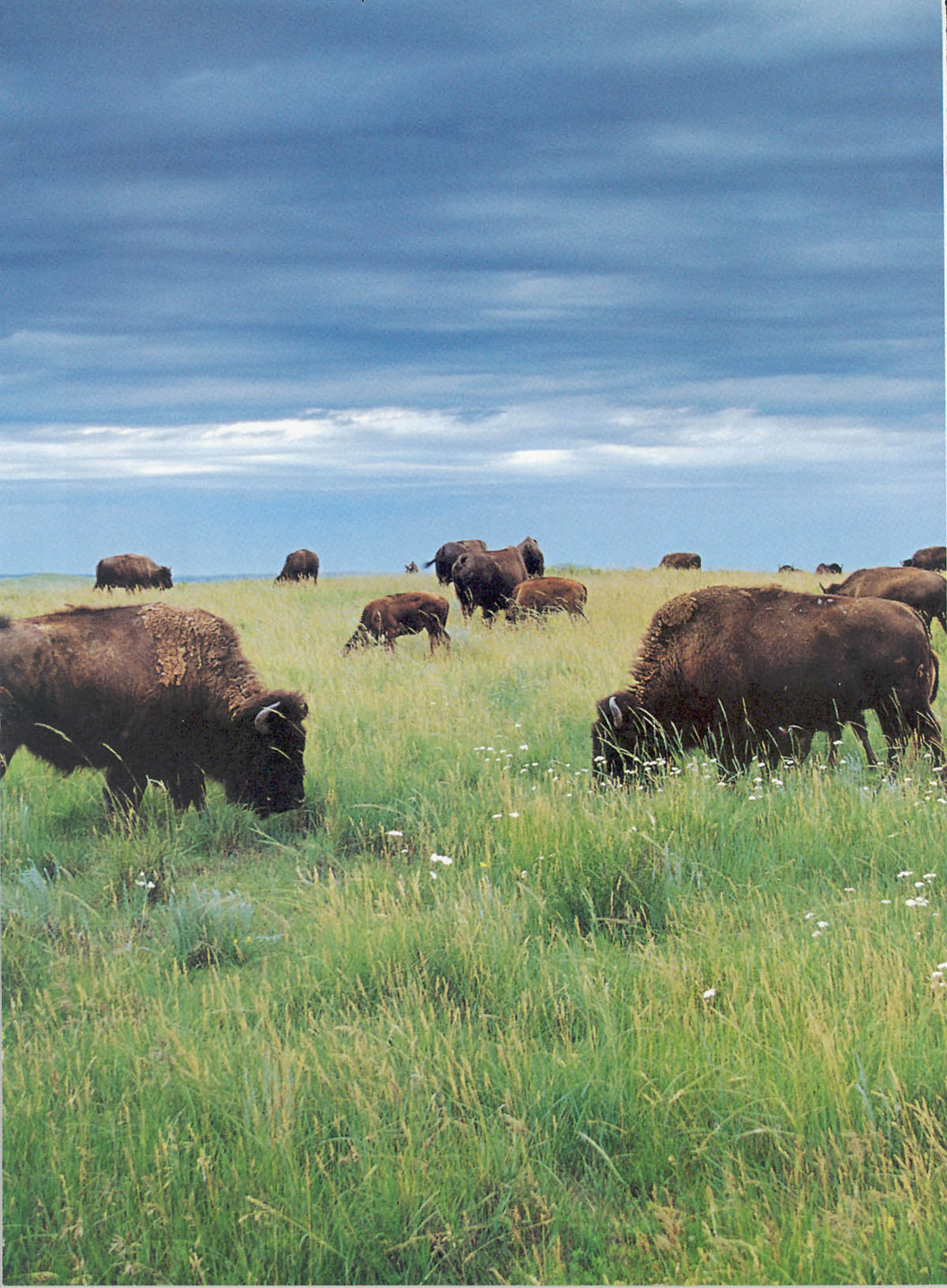
The number of bison in North America before the Europeans arrived has been the subject of great debate. They were found on the Great Plains, east of the Mississippi River and west of the Rocky Mountains. Pressure from Anglo-Americans in the prairies east of the Mississippi River soon pushed the bison west onto the Great Plains. By 1830, most North American bison were concentrated on the Great Plains from Canada to Mexico.
Some historians have estimated that there were as many 100,000,000 bison in North America. More conservative estimates reduce that population to about 30,000,000. Historians and biologists have tried to estimate the “carrying capacity” of the grasslands. The numbers of bison and other grazing animals could not exceed the amount of grass they needed to eat. The figure of 30,000,000 head of bison seems to match up well with the resources necessary to support them.
Bison have an important position in the history of North Dakota. These animals roamed the northern plains before humans arrived in North America. They evolved from the huge, wide-horned beasts of ancient times to the still huge, but much smaller animal we see today on ranches and in parks.
For thousands of years, American Indians depended on bison as a major source of food and other goods. Both nomadic tribes and sedentary villagers hunted bison herds every year and used every bit of the carcass to make their lives comfortable.
As industries expanded in the United States, bison hides became useful materials for industries. However, free-roaming bison were not compatible with farming and cattle ranching. Bison hunting also supported American Indians who resisted expansion of white American settlements. The presence of bison herds on the Great Plains raised concerns about continuing advancement of U.S. enterprises and settlement.
To some people, bison hunting seemed to be the solution. By 1885, hunting, along with changes in the natural environment, reduced the North American bison to a few hundred animals. Farms and railroads reduced the herds’ access to the grasslands, and they were no longer able to roam the Plains to locate food and shelter. In the 19th century, most people did not care about causing the extinction of a species. However, a few people understood that the loss of bison would be a biological and historical catastrophe.
Because of the efforts of William Hornaday and ranchers like Scotty Philip of South Dakota, the bison did not die out. A few head of bison were gathered up in a small herd on Philip’s ranch where they thrived and became the foundation of modern bison herds.
American Indian Bison Hunting
The grasslands of the Great Plains once supported as many as 30,000,000 head of bison. These huge animals (mature bulls weigh a ton or more) roamed the Plains seeking grass and water. They gathered in large herds during the summer. In the summer of 1804, explorers Lewis and Clark reported seeing a herd of 20,000 bison at the mouth of the White River (just south of Pierre, South Dakota). (See Image 2) Explorer and mapmaker Stephen H. Long on his 1820 expedition saw bison herds so dense that the grassy plains appeared to be black instead of green.
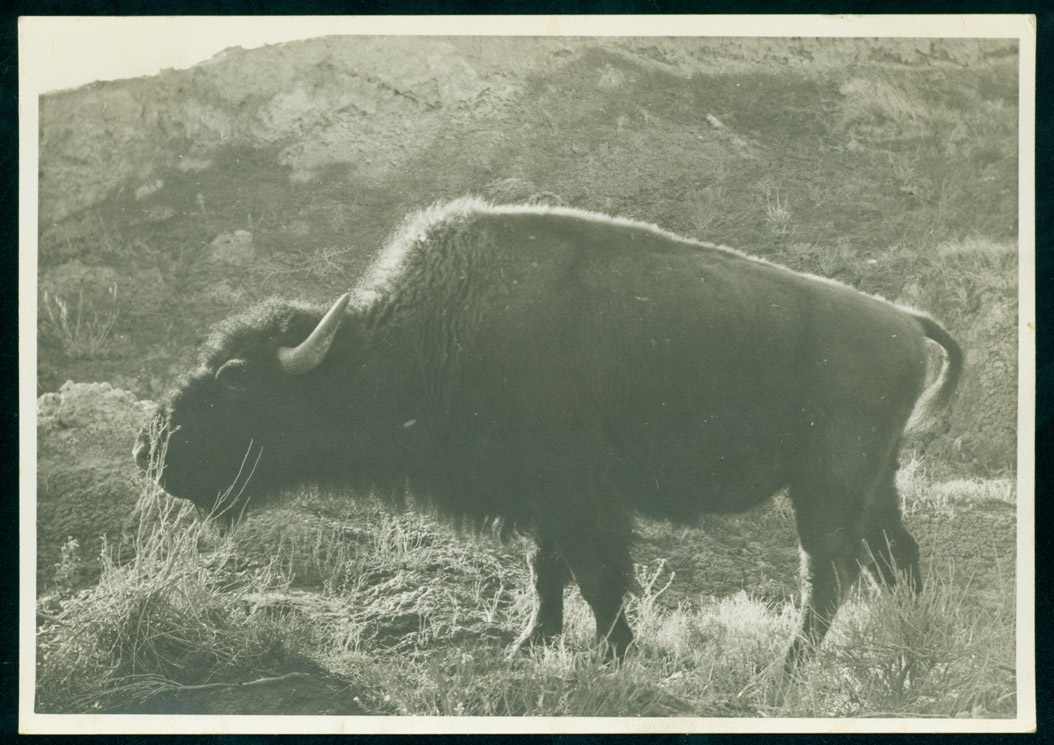
Bison were not the only animals crowding the plains. Pronghorn antelope, elk, deer, and, by 1800, wild horses foraged across the plains. The American Indian tribes of the Great Plains organized late summer and early fall hunts each year to provide for a winter supply of meat. For this purpose, entire villages moved to find the bison. Men hunted and killed the animals; women skinned the carcasses and processed the meat.
Some bison meat was eaten fresh, but most of the meat was cut into thin strips and dried for use later in the year. Women combined dried meat with berries and fat collected from the bison carcass to make a well-preserved, highly nutritious food called pemmican.
American Indians used all of the parts of the bison carcass. The hides were scraped and tanned (preserved) to make clothing, tipi covers, and bedding. A single bison hide was wrapped fur-side-out around a wood frame to make a small, round boat called a bull boat. Scraped, untanned hides, or rawhide, were dried and formed into containers called parfleches (PAR fleshes). Parfleches were used to store food, clothing, or tools. The bones were used to make tools to form flintstone into points for arrows or spears. Bones were shaped into scrapers for cleaning hides. The hair was twisted and braided into rope. The stomach (rumen or paunch) and the bladder were dried and used to hold water. There were many more uses of the bison carcass.Nothing went to waste.Hunting was not strictly an economic activity for American Indians. To really understand how and why American Indians killed bison, we need to understand that there was a religious aspect to bison hunting. Different tribes had different rituals. Each tribe had its own religious understanding of the place of bison and other animals in their culture. We can say generally, that the animals were killed with respect for the gift of life they gave to people.
For the American Indians of the Great Plains, the bison was fundamental to their economies. It provided food, household goods, materials for hunting and warfare. By the 1830s, the market for bison hides in eastern industrial cities had reached into the Great Plains. The Assiniboines, Lakotas, Hidatsas, Arikaras, Mandans, Dakotas, and Chippewas traded bison hides and meat at trading posts in Dakota Territory.
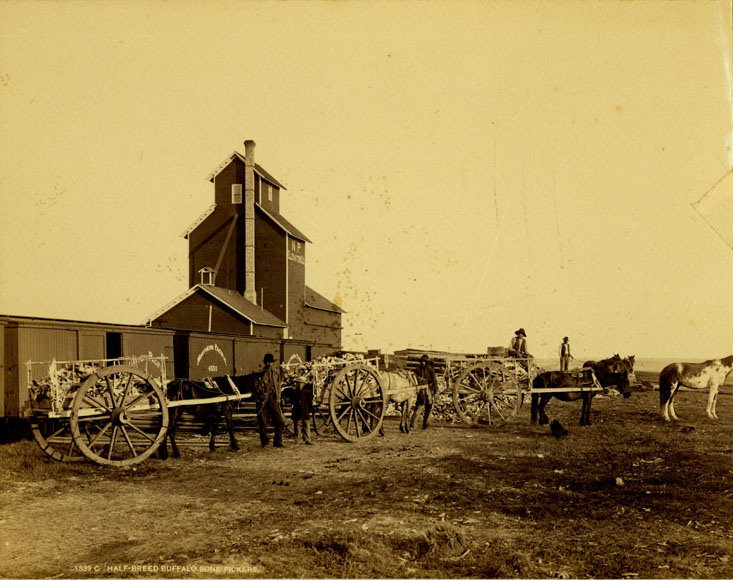
Most of the hunting for trade was limited by the traditions of Indians who believed in hunting to meet their needs, not to acquire surplus. However, traders introduced gifts of trade goods (beads, metal goods, cloth) and alcohol into the bison hide trade. These gifts led to increased hunting for trade. When the trade turned from fur-covered hides to hides that would be tanned for leather, American Indians continued to participate in the bison hunts. American Indians harvested about 25 per cent of the hides sold to manufacturers in the 1870s and 1880s. (See Image 3)
As hunting reduced bison numbers, General William Sherman, general in chief of the Army, knew that there would be serious consequences for Plains Indian tribes. When Sherman signed the Fort Laramie Treaty of 1868, he wrote to a friend that Indian hunting rights guaranteed by the treaty would end as soon as the bison were gone. After the herds disappeared, Indians could no longer resist the move to reservations.
Why is this important? American Indians hunted bison for thousands of years, but their hunts did not diminish the size of the herds. If American Indians had been the only hunters in the market trade, they probably would not have destroyed the bison herds. However, the trade was so profitable for Indians and non-Indian hunters that the hunt continued until the bison were nearly extinct. For American Indian tribes, this meant the loss of their economy. They could no longer make a living as they had for thousands of years.
The Great Bison Hunts
The market for bisonThe other word for bison is buffalo. Today, more bison ranchers are using the term bison rather than buffalo. There are no true buffalo, such as the water buffalo, in North America. The Latin, or binomial, name of American bison is Bison bison. meat in the villages and towns that were growing on the Great Plains led to intensive hunting. In addition, hunting for sport took a toll on the herds. John James Audubon, the great naturalist who traveled to the northern Great Plains in 1843, observed the remains of bison killed, as he said, “for nothing.”
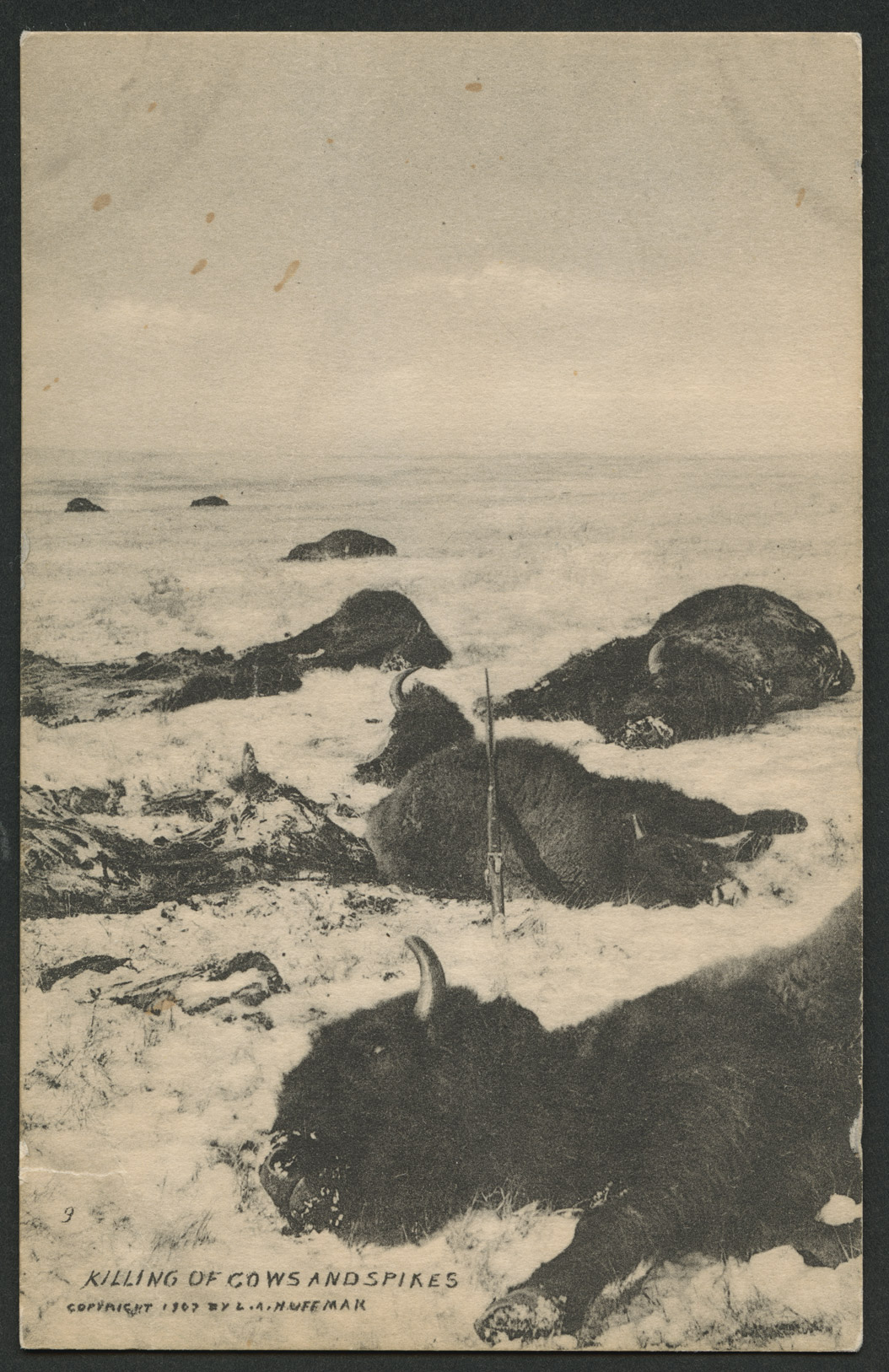
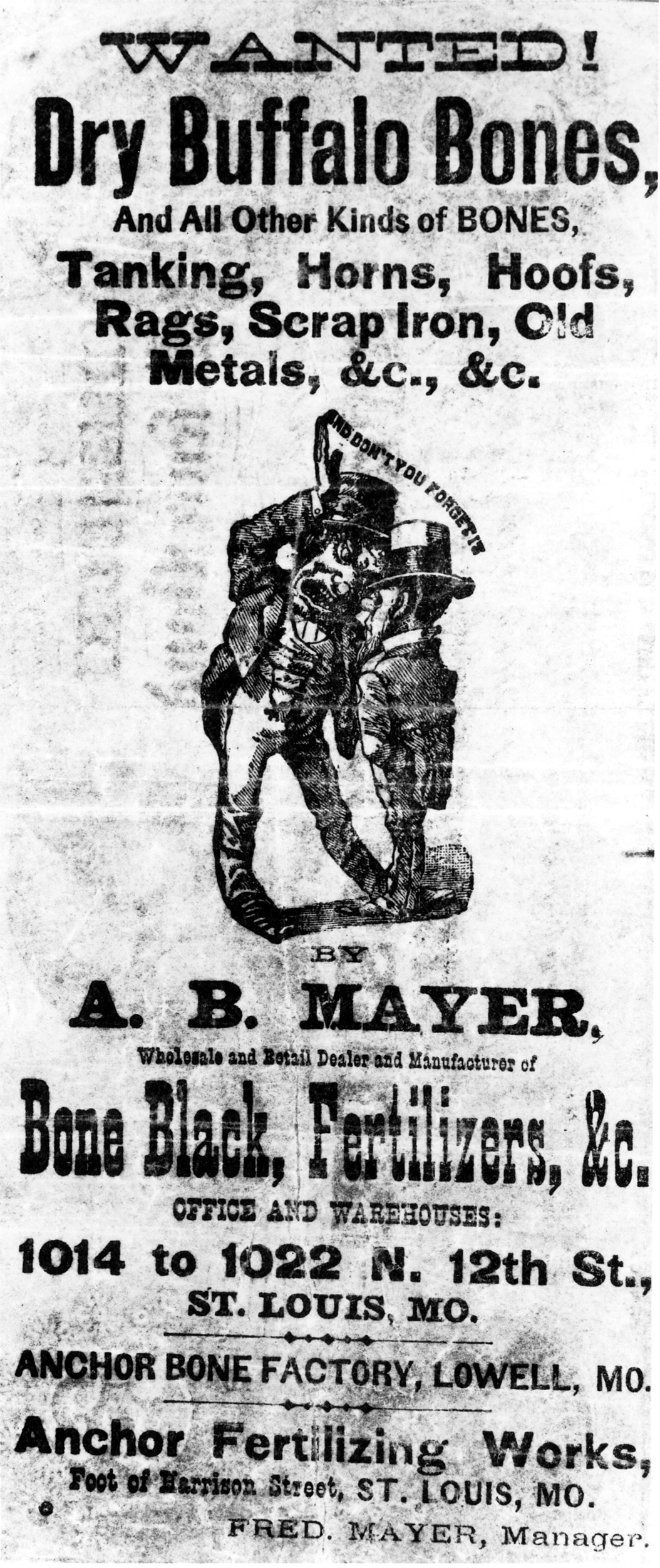
Some sport hunters took a trophy bull and returned home. Others slaughtered bison and other animals without restraint. The wealthy Irishman Sir St. George Gore may have been the worst of the trophy hunters. He boasted that during a two year hunt on the Plains in the late 1850s he shot 2,500 bison. His thoughtless actions angered American Indians and fur traders, but there was no legal means of stopping him. While Gore’s slaughter of bison disgusted the people he met on the Plains, his stories contributed to the rising public interest in bison hunting. (See Image 4)
Railroads brought men west to hunt on excursion trains in the central Great Plains. Hunters often shot at bison from train cars. Hides, horns, and heads of the slaughtered animals were shipped east by rail. Buffalo horn furniture and buffalo hide coats became popular household items in the homes of wealthy Easterners.
After the Civil War, new industries began to increase the demand for belts to drive machinery. Before 1870, it was not practical to tan bison hides by the same process used in tanning cow hides. When a new process made it possible to tan bison hides for industrial use, commercial hunters could make good money hunting bison. Thousands of bison were killed to provide the raw materials that tanneries needed. (See Image 5)
New manufacturing techniques and the demands of the Civil War led to the development of new types of guns which made hunting easier and safer. Hunters did not have to be close to a dangerous animal in order to kill it. Commercial buffalo hunters used a Sharps .50-caliber rifle. These powerful, long-range guns fired a heavy slug (a solid piece of lead) propelled by 105 grains of powder.
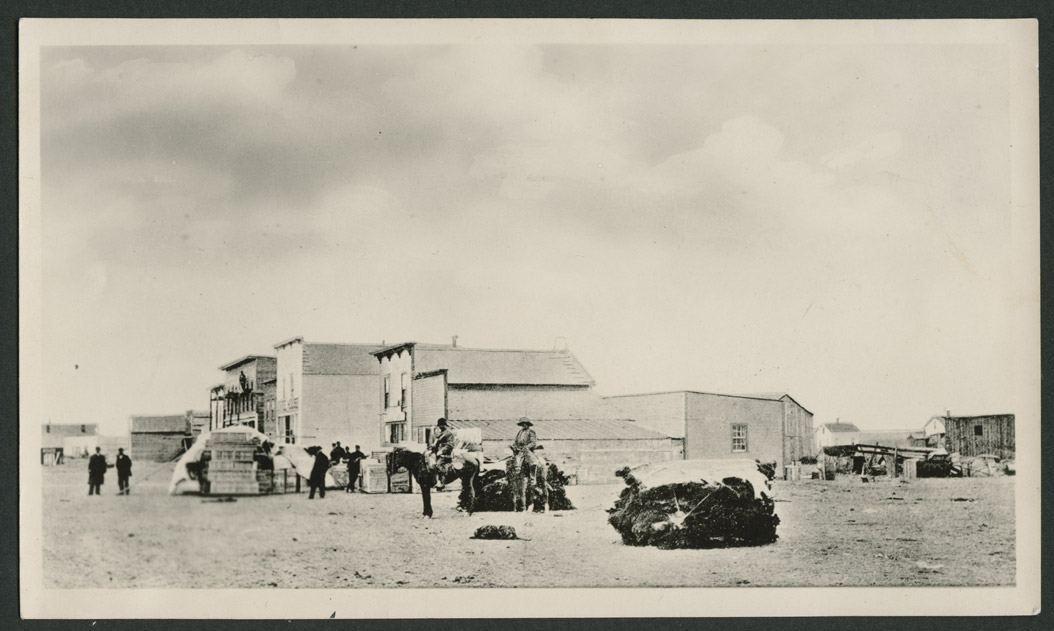
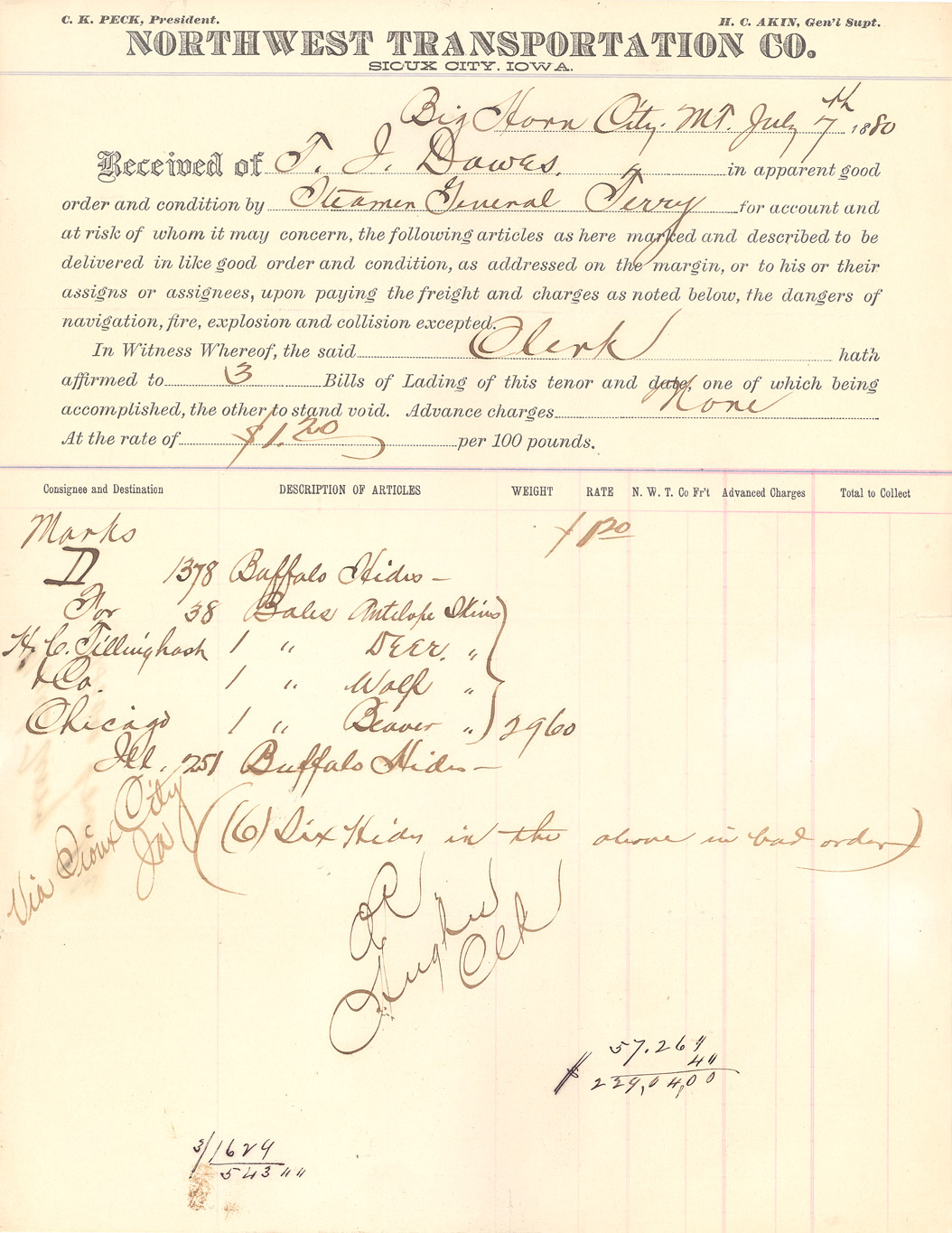
The big hunt for bison hides for the industrial market began in the early 1870s among the herds on the Southern Plains. By 1879, those herds had been reduced to a few hundred animals and the hunt moved north. (See Document 1) The Northern Pacific Railroad construction reached Miles City, Montana in 1881. Hide hunters could ship their hides to tanneries in New York and Pennsylvania by rail from Sully Springs or Dickinson, Dakota Territory. (See Image 6) There was little market for the meat which was usually left on the carcasses to rot. (See Document 2)
Document 1. George Newton’s bison hunt
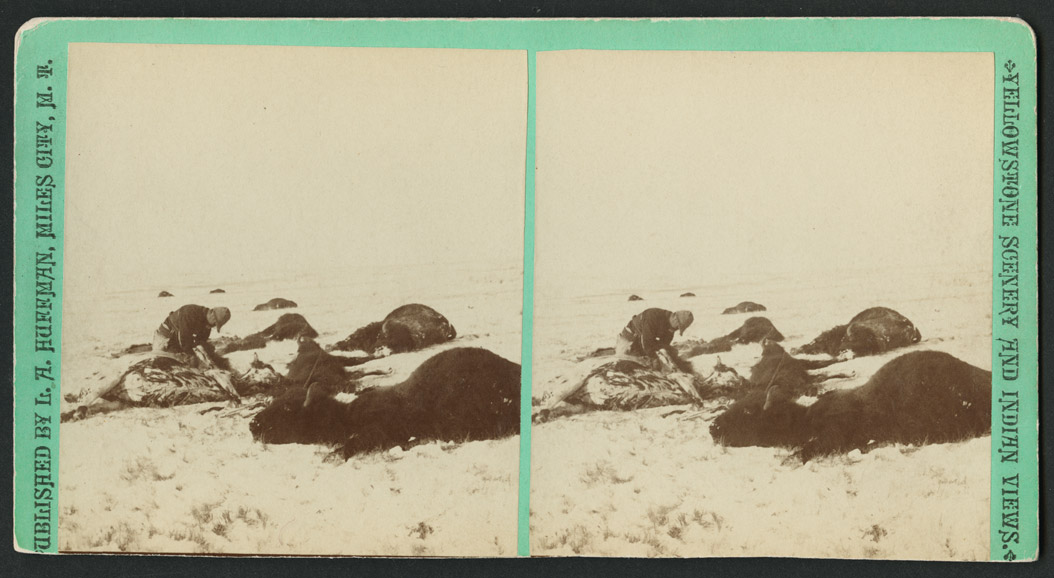
George W. Newton was born in Philadelphia in 1858. At the age of 14, he left home for adventure. In 1878, he went to Bismarck where he met bison hunters who taught him to hunt and market his hides. He set up his own bison hunting business. Newton, a very good skinner, could skin as many as 30 bison carcasses a day. Newton discussed bison hunting with Usher Burdick (Lieutenant Governor of North Dakota,1911-1912, and U. S. Representative to Congress,1935-1945) who wrote about Newton in a book titled Tales from Buffalo Land: The Story of George “W” Newton. (Baltimore: Wirth Brothers,1939). In this excerpt from the book, the editor has used elipses (. . . ) to show where passages from the book were not included, and added explanatory words in brackets [. . .].
When an actual killing would begin, the hunters would take a position where the wind was blowing directly from the herd to the hunters to avoid any chance of the presence of the hunters being detected by the sense of smell of the buffalo. Being thus properly located the next prerequisite was dexterity of the marksmen in properly shooting the buffalo. For example, if the first shots would wound the animal he would stampede and with him would disappear the entire herd. By dexterious marksmanship, however, the buffalo was either shot through the heart or liver and instead of stampeding would become sick and immediately lie down and by this method the balance of the herd would not be disturbed.
In the very early buffalo days, the firearms used were usually Sharps rifles of .45-70 caliber, but these rifles were slow in effect and it sometimes took several shots to reach the vital spot, and larger guns came into use. With these guns the report would be heard several seconds before the mark was hit. The guns in use were .45-70, .45-90 and .45-105, and the last one used in the buffalo days was a [Sharps that shot a] .50 [caliber] -180 [grain bullet], weighing twenty-one pounds. This last gun was the most effective of any of the guns used.
The hunter, of course, endeavored at the beginning of the shoot to fell the leader of the herd, which was usually a huge buffalo bull. The highest number of buffalo killed by Mr. Newton in any one stand was sixty, although there are many hunters who exceeded this number. As far as we are able to determine, Doc Zahl, a resident of Williston until his death a few years ago, was perhaps the greatest buffalo hunter of the West. Mr. Newton gives Doc Zahl credit for killing 120 in one stand.
The purpose of this hunt was to secure buffalo hides. A prime robe was worth $4.00 and . . . regular bull hides were worth only $2.75 and calf hides, $1.75. A prime robe was usually of finer texture and came from buffalo cows, or from a “spike.” A “spike” was a young buffalo bull under the age of three years. As soon as the young bull took on age the hide would thicken and toughen and its only use was for tanning purposes.
After the killing had been completed the skinners would come on the field and procure the hides and spread them up on the prairie where they would dry in the sun. [See Image 7] When dry they were stacked up a good deal like shingles and kept until the buyers came through on their annual purchase trip.
In the winter of 1880-1881 George Newton went to work for himself in the buffalo business and had as his partner John Herbert. . . . In the winter of 1880–81 this new firm killed thirteen hundred buffalo. In the winter of 1881–1882 they killed nine hundred, and in the winter of 1882–1883, they killed thirty seven. . . .
. . . in the spring of 1883 no spring hunting was done of any consequence, but the buffalo were seen to drift gradually northward in the direction of Canada and the supply dealers and the hunters had every reason to believe that in the fall business would begin, but a very strange situation developed. No herds of buffalo ever came back from Canada in the fall of 1883. The buffalo had disappeared like magic. . . .
Newton . . . was able to locate only a small herd of thirty-seven buffalo in the winter of 1883, about fifty miles north of where Poplar, Montana is now located. The exact location of the herd was on Willow Creek, which is a branch of the Milk River. It was with this herd perhaps that Newton demonstrated his best skill as a hunter. By complying with the rules of successful killing as set forth in this story, Newton felled the leader and succeeded in wiping out the entire herd of thirty-seven in a single stand. The animals were skinned. . . . Upon his return to the scene of the killing two days later, he was unable to find any trace of the hides or the carcasses, so that the entire lot of hides were lost to the hunters.
Naturalist William Hornaday estimated that between 1881 and 1883, 300,000 hides were shipped from the northern Plains to eastern tanneries. Some people argue that his figure is too low. However, by 1884, the hunt declined as drought and increasing numbers of domestic cattle destroyed the grasses that bison depended upon. Domestic cattle diseases such as tick fever and bovine tuberculosis further reduced the remaining bison herds. Only a few hundred hides were shipped in 1884.
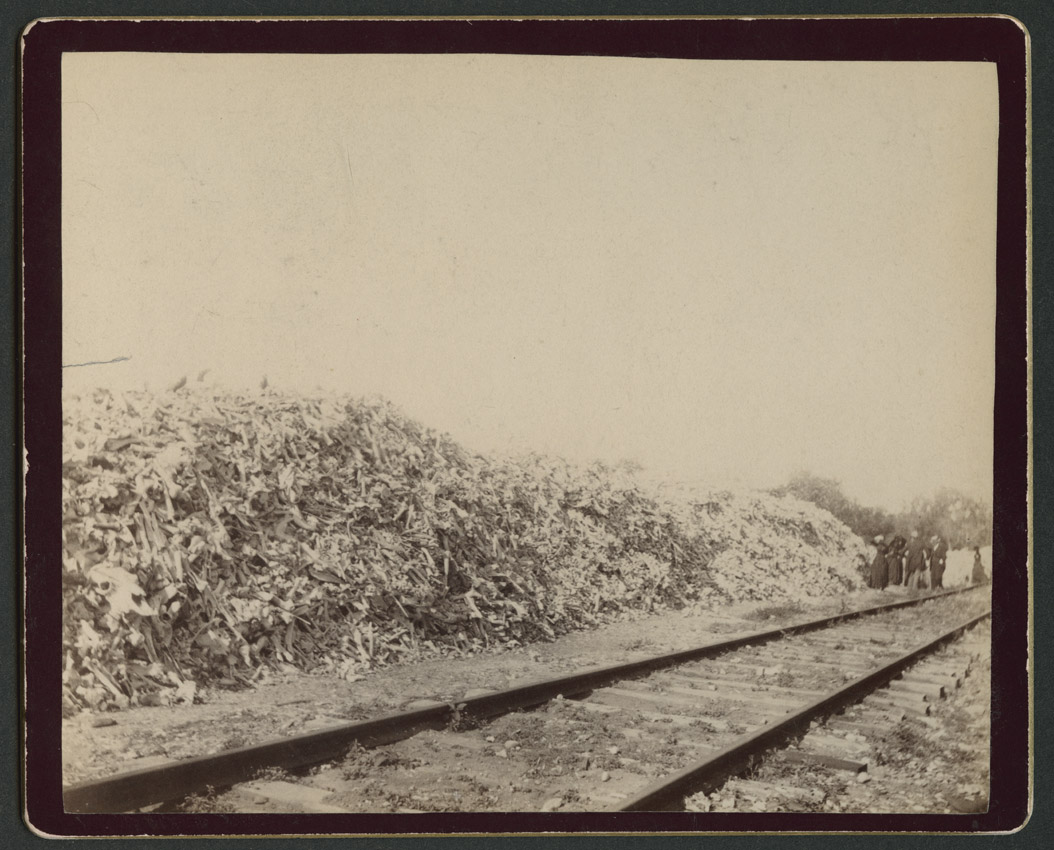
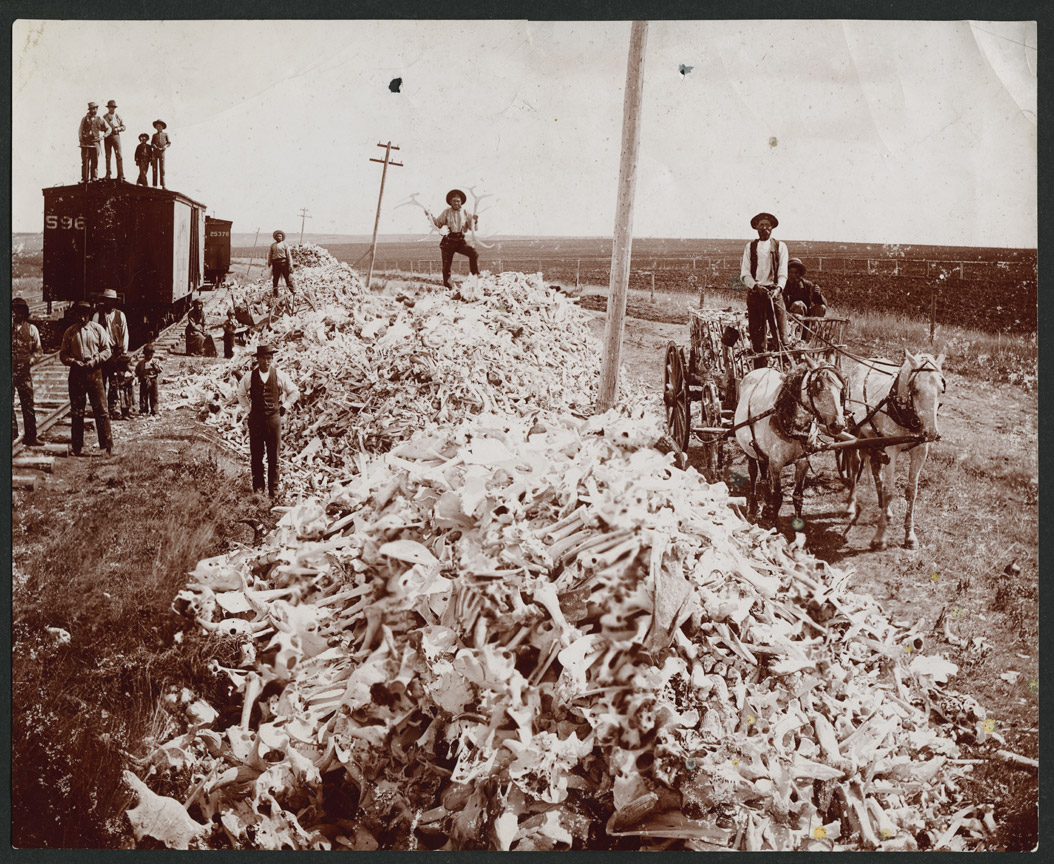
Though the bison herds disappeared, the bones of the great animals left on the land also had industrial uses. Pioneers could pick up bison bones and sell them for $10 per ton to dealers at local railroad depots. (See Image 8) The bones were shipped to factories in St. Louis and Detroit where they were made into glue or fertilizer. (See Image 9) Bones were also processed into charcoal used for filtering and purifying sugar syrup. The bone market ended in the late 1890s.
The once numerous bison faced extinction by 1885. William Hornaday set out to count them in 1889. He found 285 animals on federal land, mostly in eastern Montana. Another 256 grazed in private herds around the American West. Canada’s bison herd numbered 550. The efforts of a few ranchers who kept bison saved the animal from extinction.
Why is this important? The loss of a species affects other species as well. The grasslands needed the fertilizer the bison left behind. The grasses also benefitted from the action of bison hoofs running across the prairie. Birds and insects also interacted with the bison. The destruction of the bison herds demonstrates the power of eastern industries to shape the economy of Dakota Territory. However, farmers could not successfully raise crops if huge herds of bison roamed Dakota. The killing of the bison herds ended one era, and opened the door for another.
Federal Law: Hunting on Indian Land
In 1834, Congress passed a bill stating that all the land west of the Mississippi River (except for the states of Arkansas and Missouri) would be “Indian Country.” The bill was titled: An act to regulate trade and intercourse with the Indian tribes, and to preserve peace on the frontiers. (June 30, 1834) This important bill regulated all trade and contact (also called “intercourse”) between whites and Indians. The law stated that traders had to be licensed. Traders could trade only for furs or hides, not Indians’ goods or guns. The law also stated that no one was allowed to take any alcohol into Indian Country. The Army was authorized to enforce the law. (See Image 10)
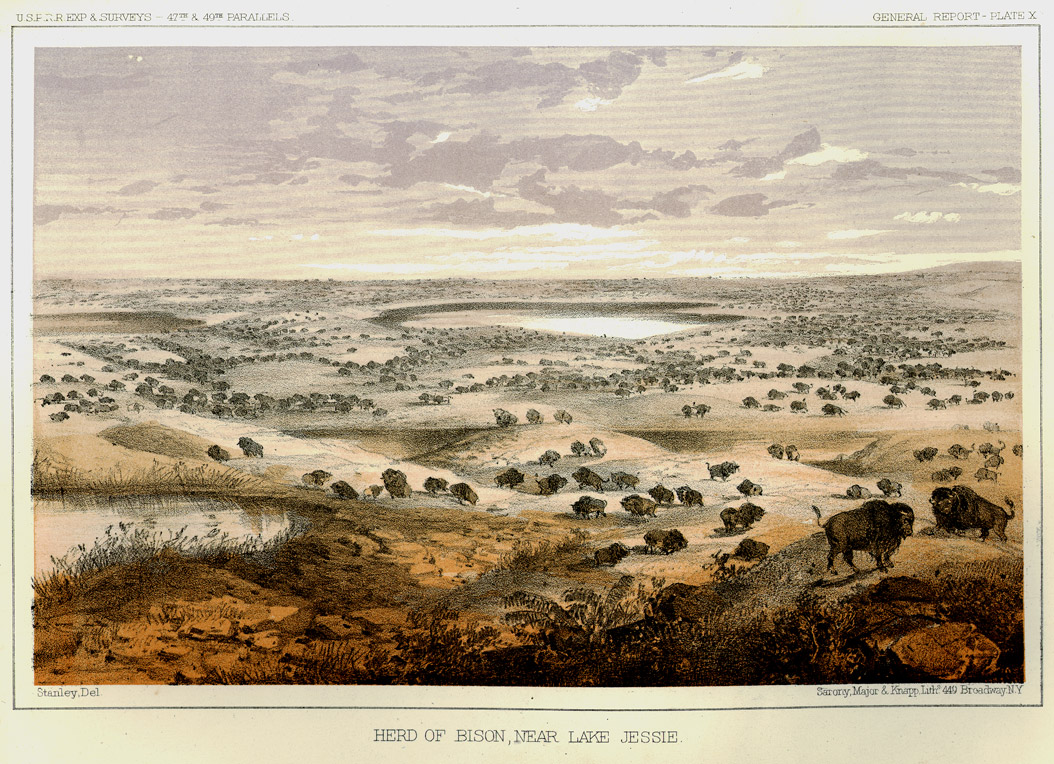

This law made it illegal for commercial hunters to hunt bison in Indian Country. However, the boundaries of Indian Country got smaller as reservations were created. Nevertheless, much federal land in the West was Indian Country until 1868 when the Fort Laramie Treaty of 1868 reduced the boundaries even further.
Indians tribes often had trouble with commercial bison hunters entering their land to hunt. In 1882, five hunters set up camp on the Standing Rock Reservation where they killed and skinned at least 1,000 bison. They were arrested, but since no one among the Dakotas actually saw the hunters kill an animal, the hunters were not charged with trespassing or violating any federal law.
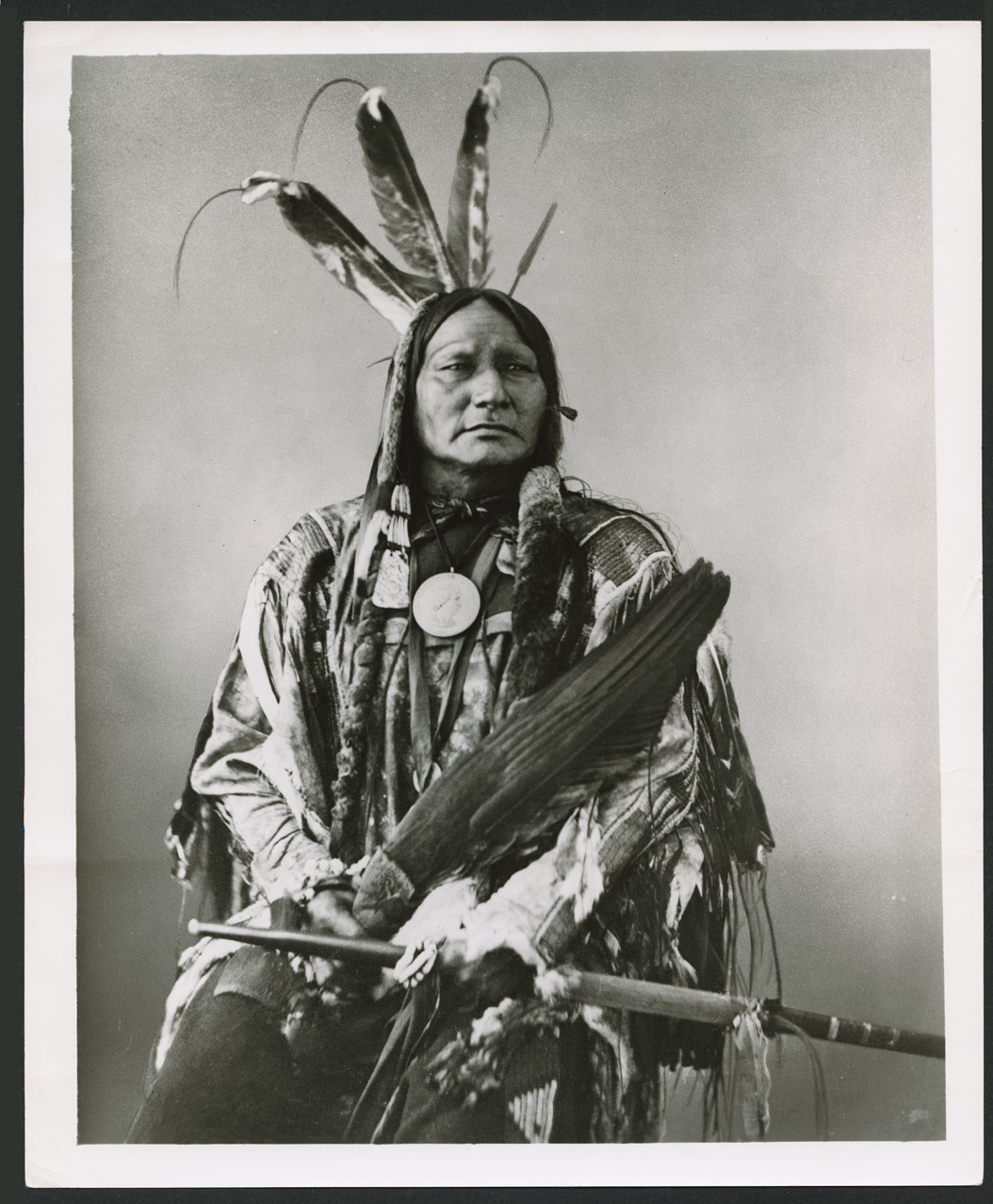
Running Antelope (1821 - 1896), a highly respected speaker and diplomat of the Sioux (Dakota) nation, (See Image 11) became weary of the failure of the law and Indian agents to protect Sioux lands and resources. (See Document 3) In an interview with the editor of the Bismarck Tribune, Running Antelope said:
"If the present slaughter by the white men continues, buffalo will not last more than two years. If the white men were not permitted to kill the buffalo just for the hides, then they would last several years yet. I think it is a pity that the white men slay the buffalo for their hides and leave the good meat on the grass. The Indians to whom the buffalo belong are poor; if they only were allowed to kill the buffalo they would save every bit of the meat for their families. I have done the best I can for the white men and I do not see why the Great Father cannot do me the favor of stopping the whites from killing our game.” (Bismarck Tribune, February 16, 1883).
Why is this important? Federal law clearly protected bison on Indian reservations or “country,” but there were too few federal marshals or soldiers to enforce the law. While Indians understood the law and often knew of violations, they were seldom considered believable witnesses in the 19th century. Because of poor enforcement and a general public sentiment that favored bison hunting over Indian rights, violations of the law continued until the bison were eliminated from North Dakota.


